
National Park Service technicians assembling ceramics recovered from Jamestown, Virginia, with some of the May-Hartwell collection in the foreground, 1938. (Courtesy, National Park Service, Colonial National Historical Park. Photo # 7030.)

Mug, Frechen, Germany, 1660–1680. Salt-glazed stoneware. H. 5 1/2". This mug with applied seal was recovered from the North Sea. The globular form and the shape can also be seen in silver and earthenware mugs of the period. Documentary and archaeological evidence suggest that similar forms were made in England as early as 1660. Characteristic of later English brown stoneware, the mug was dipped into an iron wash or slip before firing creating the rich brown mottled or freckled appearance.

Mug, Westerwald, 1695–1702. Salt-glazed stoneware. H. 5 1/4". This example has an applied portrait medallion of King William III

Mugs, London, 1700–1720. H. 4 7/8" and H. 5 3/8". The mug on the left is attributed to John Dwight’s Fulham pottery and dates ca. 1703. It has an applied Britannia medallion and an “AR” excise mark below handle. For similar examples and further reading, see Chris Green, John Dwight’s Fulham Pottery Excavations 1971–1979 (London: English Heritage, 1999), pp. 134–35 example A, and for the medallion, see p. 269. The mug on the right is ca. 1720 and has the impressed excise mark “WR.” These excise marks were required by a British Act to ensure standardization of capacities in the tavern trade of beer and ale. As the Act originated in 1700 during the reign of King William, the WR excise mark was typically used throughout the eighteenth century.

Mugs, Germany. Salt-glazed stoneware. Left: Impressed with “AR” cipher for Queen Anne (1702–1714). Right: Impressed with “GR” for King George I (1714–1727). H. 6".

Mug, Bristol, 1719. Salt-glazed stoneware. H. 5 1/2". An unusually early dated mug with an impressed “GR” excise mark in an oval. The GR marks appear to have been adopted only by stoneware manufacturers in Bristol.
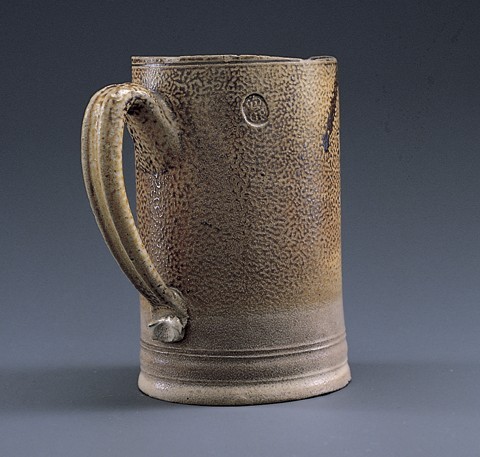
Mug, Bristol, 1719. Salt-glazed stoneware. H. 5 1/2". An unusually early dated mug with an impressed “GR” excise mark in an oval. The GR marks appear to have been adopted only by stoneware manufacturers in Bristol.

Mug, Fulham, 1750. Salt-glazed stoneware. H. 5 1/8". A tavern mug inscribed “Jacob Morden 1750” with the sign of the rooster on its medallion.
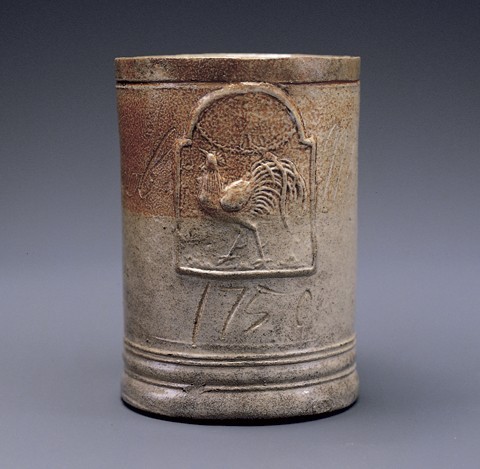
Mug, Fulham, 1750. Salt-glazed stoneware. H. 5 1/8". A tavern mug inscribed “Jacob Morden 1750” with the sign of the rooster on its medallion.
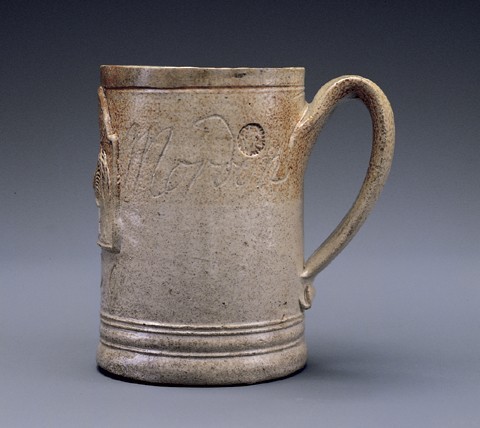
Mug, Fulham, 1750. Salt-glazed stoneware. H. 5 1/8". A tavern mug inscribed “Jacob Morden 1750” with the sign of the rooster on its medallion.
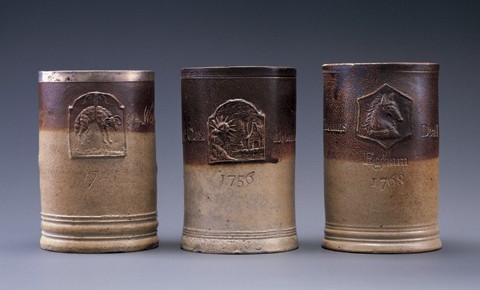
A group of mugs with applied tavern signs, London. Salt-glazed stoneware. Left: H. 6 3/4. Quart tankard inscribed “Wm. Kemp in Wells, 1741” with the tavern medallion of the Golden Fleece with “WR” excise mark. Middle: Important quart tankard impressed using printer’s type “JN. Cox Bromley 1756.” This is the earliest recorded tankard using printer’s type to impress its letters and date. Previously, the earliest recorded tankard using this method was dated 1758. (See Adrian Oswald, Robin J. C. Hildyard, and R. G. Hughes, English Brown Stoneware [London: Faber & Faber Limited, 198]), p. 43.) WR excise mark and the medallion of the “house of the rising sun.” One other rising sun medallion is known on an eighteenth-century jug. Right: London quart salt-glazed stoneware tankard with the tavern sign “horses head” on its medallion. Printer’s type impressed “Thomas Deall Egham 1768.” WR excise mark.

Mugs. Salt-glazed stoneware. Left: Bristol, 1755. H. 6 3/8". This mug is incised in freehand with “Thos. Carter at ye Green Dragon Zeals Green 1755” and has an impressed GR excise mark. It is the latest dated hand incised example in the collection. Right: London, 1766. H. 4 1/4". This pint mug is impressed with printer’s type “Wm. Murrells Sulbery 1766” and has an impressed WR excise mark.

A group of mugs, Germany. Salt-glazed stoneware. H. of tallest: 5 5/8". Examples of tavern mugs of the type exported to England and the American colonies. Virtually all American archaeological sites dating between 1720 and 1760 contain fragments of such vessels.
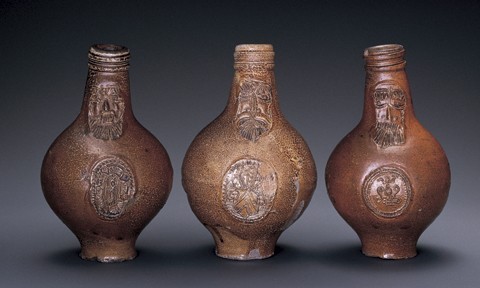
A group of bottles, Frechen, ca. 1680. Salt-glazed stoneware. H. of tallest: 9 1/4". During the seventeenth century, German “bellarmine” bottles were used throughout western Europe and North America as the containers of choice for wine, oil, and other liquids. Their ubiquitous presence is evidenced by numerous archaeological specimens found in Anglo-American contexts. These specimens are typical examples with the distinctive bearded mask and applied seals. The pronounced lips were used to fasten wires over the corks that sealed the bottles. Collectors commonly use the term bellarmine in referring to these bottles. In the period, the Germans called these jugs “bartmann” (bearded man) while the British used the term “grey beards.”

A group of bottles, probably London, 1690–1720. Salt-glazed stoneware. H. of tallest: 9 1/4". English production of stoneware bottles began in earnest in the early eighteenth century. The smaller bottles were probably used for ale and other liquors. These were eventually supplanted by the production of glass bottles. Unlike mugs and tankards, stoneware bottles were usually fired without the benefit of saggers, being stacked tightly in the kiln. Where these bottles came into contact with each other is usually evident as circular spots or indentations on the shoulders and bellies. The name “Thomas” is incised in freehand script on the left and middle bottles.

Bottle, London, ca. 1725. Salt-glazed stoneware. H. 9". An elegant form in an everyday utilitarian object.
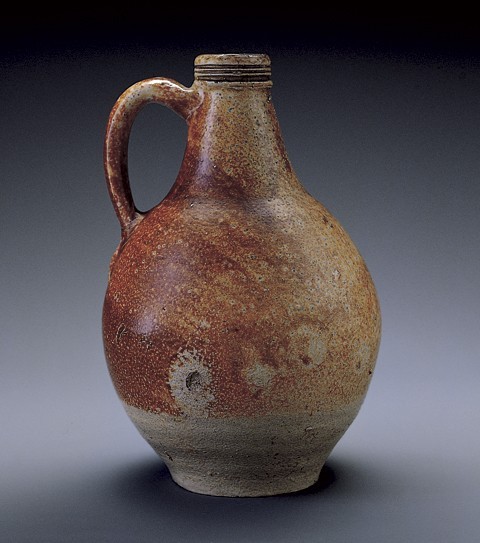
Bottle, London, ca. 1725. Salt-glazed stoneware. H. 7 3/4".
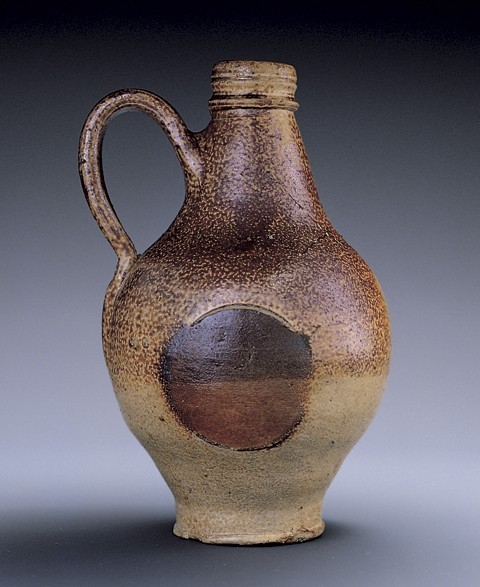
Bottle, London, ca. 1725. Salt-glazed stoneware. H. 7 5/8". The unique circular spot in this bottle is a result of its position in the kiln. The lack of salt-glaze within the circular area suggest that the bottle may have been resting horizontally on top of a mug or saggar.

Ink bottles, London, 1780–1820. Salt-glazed stoneware. H. of tallest: 3 1/2". These small bottles contained ink or pigments. The bottle on the left is impressed “SCOTT, 417 STRAND.” John Scott was listed in the London Directory as “water Colourman to her Majesty” at this address from ca. 1790–1839.
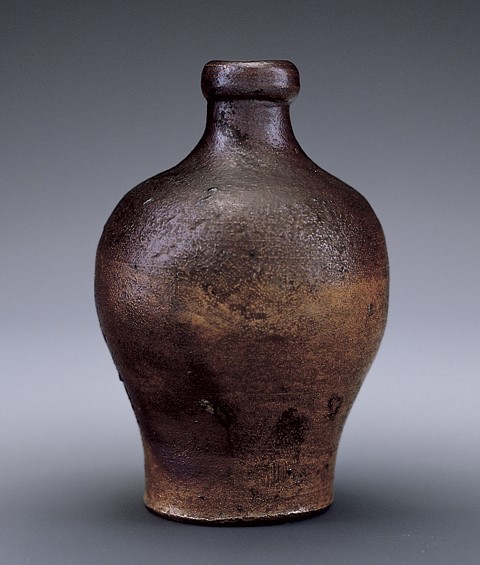
Bottle, London, ca. 1780. Salt-glazed stoneware. H. 5 1/2". This small bottle was reputedly found in a Connecticut house cellar.
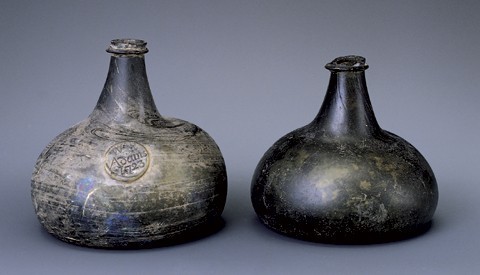
Wine bottles, England. Glass. H. of tallest: 6". The sealed bottle is inscribed “Wm. Adams 1723” and was retrieved from an English river. The bottle on the right was found in an American river. Glass bottles, whose production began in the 1660s, quickly became the standard containers for wines and related alcoholic beverages. These early examples were free-blown with the final shape being dictated by the hand of the glassblower.

A group of wine bottles, England, 1740–1760. Glass. H. of tallest: 7 1/2". These mid-eighteenth century examples were blown into a cylindrical mold in the early attempts to standardize the sizes and shapes of bottle. All three bottles have histories of being found in Virginia rivers.
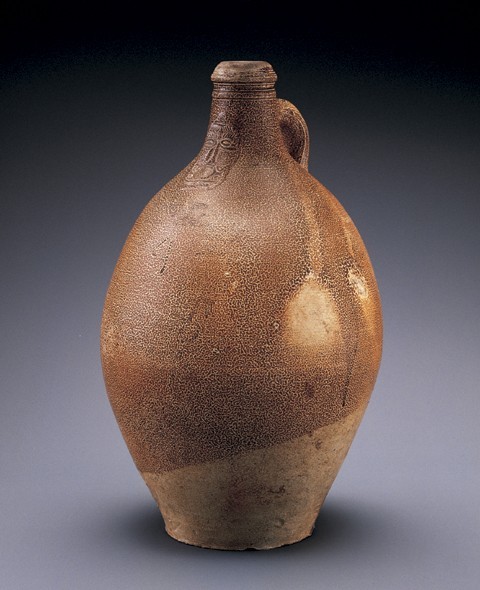
Bottle, Germany, 1720–1750. Salt-glazed stoneware. H. 17". Larger sized stoneware bottles were produced throughout the seventeenth and eighteenth centuries. This example has the applied bellarmine mask.
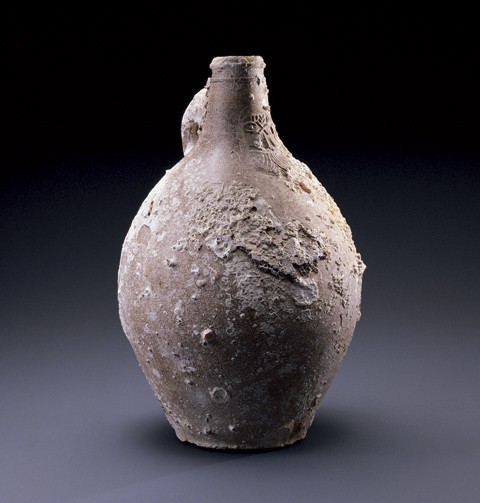
Bottle, Germany, 1720–1750. Salt-glazed stoneware. H. 15". This bellarmine-type bottle was among several dozen German stoneware storage vessels recovered from the 1752 Dutch shipwreckGeldermalsen. At the time of its sinking in the East Indian Ocean, the Geldermalsen was bound for Europe carrying nearly 100,000 pieces of Chinese porcelain. These stoneware bottles appear to have been used as storage vessels for use by the ship’s crew.

Bottle, Germany, 1750–1800. Salt-glazed stoneware. H. 18 1/8". Incised “4.” Generally, the bellarmine mask was not used after 1750.

Bottle, England, probably Fulham, ca. 1720. Salt-glazed stoneware. H. 15 1/4". The large English bottles, although used as containers for ale and other drink, were more likely used for oils, varnishes, and paints. Production of these larger st oneware bottles continued throughout the eighteenth century and well into the nineteenth. Contact firing spots are readily evident on this bottle.

Detail of a hand print on the jug illustrated in fig. 23. The potter who dipped this jug into the iron wash, while marring his finished product, left an indelible mark for future generations. Although most potters remain anonymous, their fingerprints are common traces left on utilitarian stonewares and earthenware
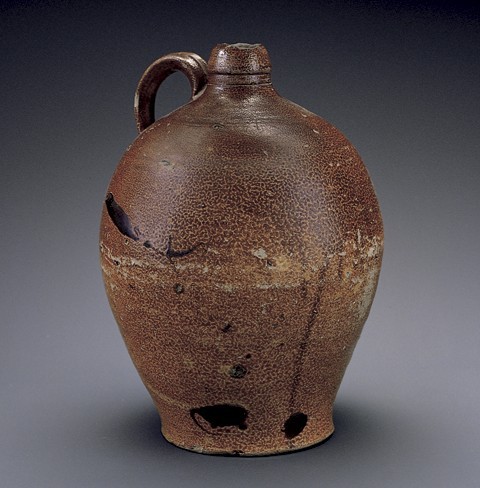
Bottle, London, ca. 1770. Salt-glazed stoneware. H. 13 5/8".
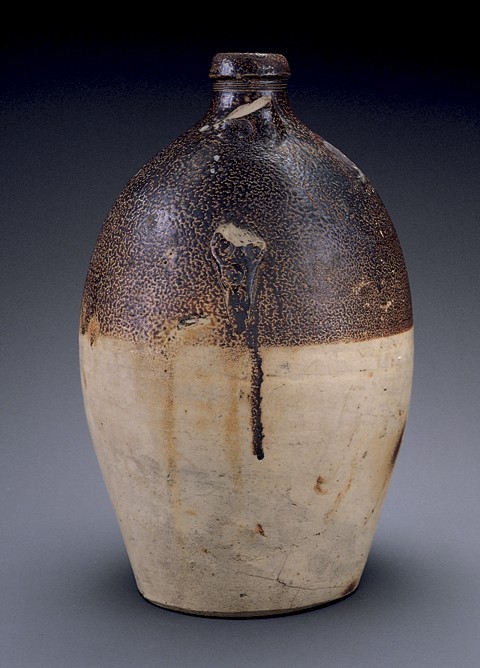
Bottle, England, probably Fulham, ca. 1740–1770. Salt-glazed stoneware. H. 16 1/2". This example with its missing handle was reputedly found in the York River near Gloucester, Virginia.

Bottle, London, ca. 1725–1750. Salt-glazed stoneware. H. 14".
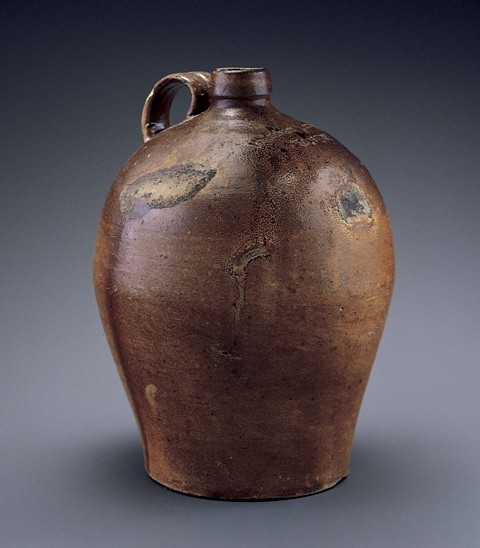
Bottle, Fulham, London, 1784–1805. Salt-glazed stoneware. H. 14 3/8". Impressed “Brandram, Templeman & Jacque,” a London firm of paint suppliers or “Colour Merchants.” Several of these historically important jugs have been recorded in Virginia including two in the Colonial Williamsburg Collection. Research suggests that Brandram, Templeman & Jacque traded in Virginia and Maryland. A fragment of a similar jug was excavated at the Fulham pottery.
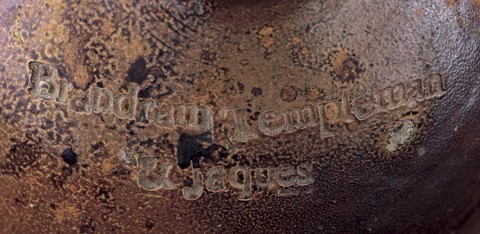
Detail of impressed mark on bottle illustrated in fig. 28.
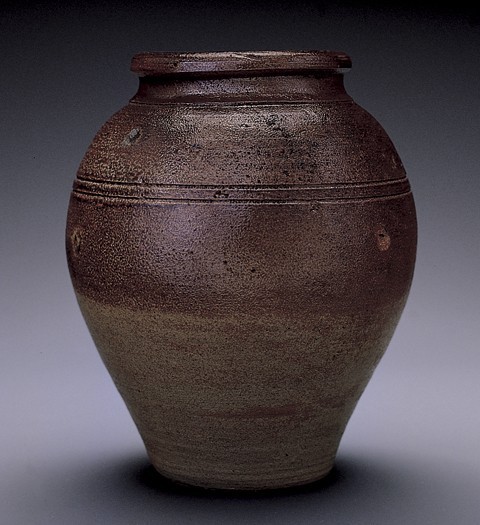
Jar, London, ca. 1720. Salt-glazed stoneware. H. 7 1/2". Jars like this served as storage containers for pickles, pastes, and other perishables.
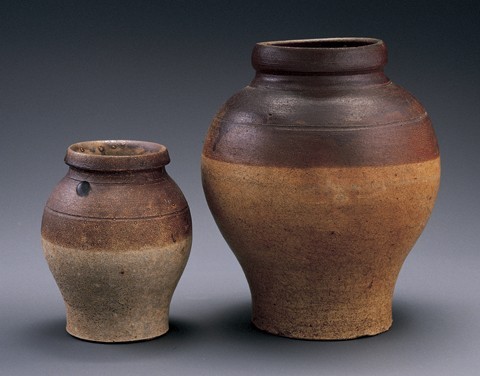
Jars, London, 1720–1750. Salt-glazed stoneware. H. 6 1/2" and 10 1/8". These storage jars probably served many purposes, although they have been referred to as snuff jars.

Jar, probably London, ca. 1750. Salt-glazed stoneware. H. 8". The bulbous shape of this jar is unusual.
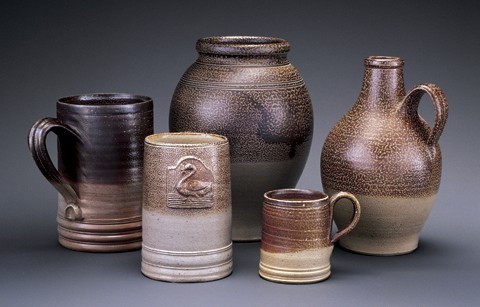
Examples of reproductions of English brown salt-glazed stoneware, 1970–2000. H. of tallest: 8 1/2". These stonewares represent contemporary products of American and English potters supplying the considerable reproduction market for historical sites, museum shops, and living history re-enactors.

Jug, Westerwald, 1691. Salt-glazed stoneware. H. 11 3/8". The incised and applied decoration includes a portrait medallion of King William and Queen Mary dated 1691. The combined use of cobalt and manganese on the body is a characteristic of late seventeenth-century Westerwald.

Jug, Westerwald, 1702–1714. Salt-glazed stoneware. H. 8 1/8". A large example impressed with “AR” (Anne Regina), the chipher of Queen Anne. Note that a small amount of manganese is used on the body decoration.
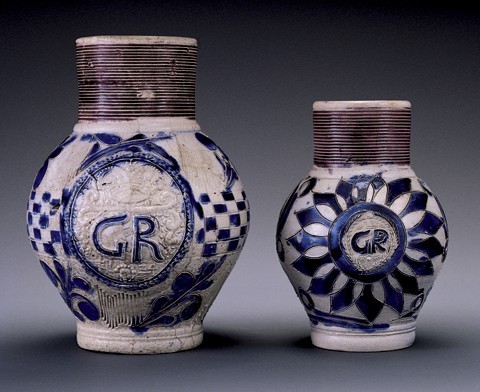
Jugs, Westerwald, 1724 and ca. 1740. Salt-glazed stoneware. H. 7 3/8". The example on the left is dated. After about 1710, the use of manganese is generally restricted to the necks of Westerwald vessels.
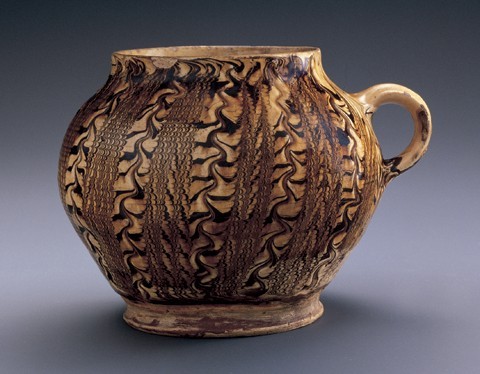
Honey pot, Staffordshire, ca. 1700. Slipware. H. 5 1/2". An early example of combed slipware with unusually fine patterning. Fragments of English slipware are among the most ceramic types found on American colonial archaeological sites and must have been used in nearly every household. The early slipwares of this type typically exhibit more care and better control in the application of the slip decoration than later examples.
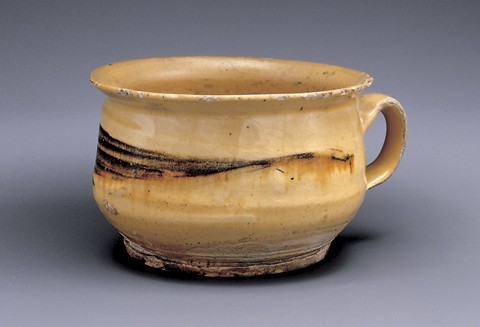
Porringer, Staffordshire or Yorkshire, ca. 1730. Slipware H. 3 1/4". A later example where the quality of decoration is more debased than the example illustrated in fig. 37.
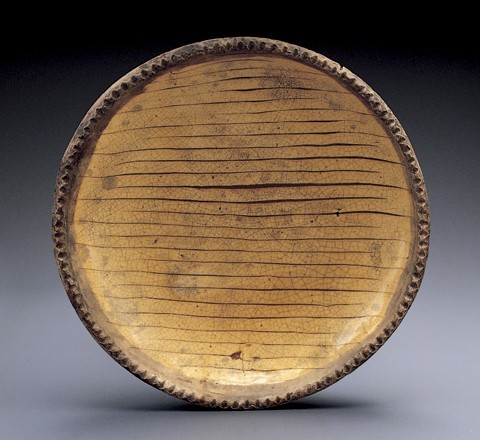
Dish, Staffordshire or Yorkshire, ca. 1750. Slipware. D. 11 1/4".
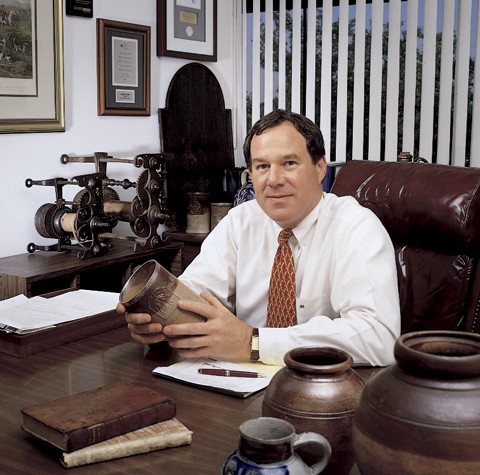
James Glenn.
